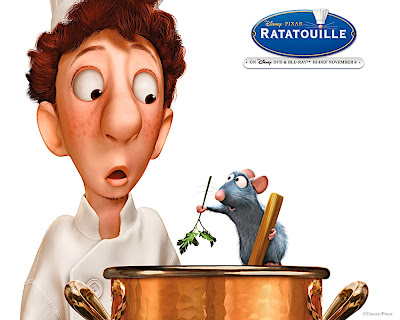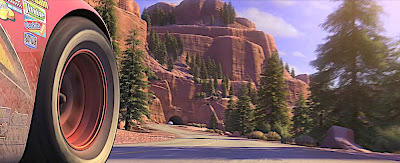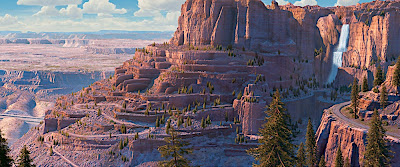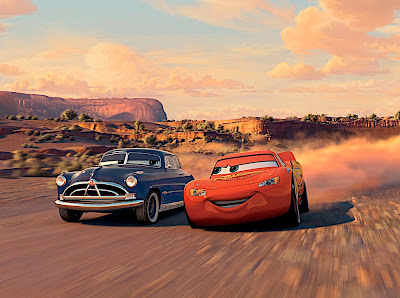surely Paris is the city most photographed, painted and adored around the world, but RATATOUILLE (Ra.ta.tui) gives us a whole new vision. The story of RATATOUILLE (Ra.ta.tui) runs in two equally wonderful places in the city: the world dazzling urban restaurants and cafes over the streets and the intricate, mysterious and hard world that runs underneath them, where Django's furry family home installed. "Paris has seen in many ways, but never before from the perspective of a rat," says Brad Bird. To deliver this new vision of the city, Bird worked closely with production designer Harley Jessup, who had to face one of the most interesting tasks for any professional animated design: not only had to reproduce the essence of the City of Light into a CG world, but had to create a landscape that was more than a background, a kind character that breathes passion and life into Remy's world. As expected, Jessup began his exciting work traveling to France with the director of photography / lighting, Sharon Calahan. "We looked over all color, shapes and surfaces," Jessup said, referring to his emotional journey. "Decided to use a palette that had not been used before. We learned that Paris has that classic style that gives the stone, dotted with traces of color. We saw a woman down the street with a red coat that stood on the gray background and that's what we wanted to play in the film. For this reason the color palette is more deaf than other Pixar films. We risking quite as animated films tend to overflow color. We use color to enhance things, and I am convinced that this contention on the color of his great strength to tape. "
As regards the frills, Jessup is contained less. "We wanted to create a classic fairytale Parisian" he adds. "It's a city that shows a lot of magic, but we all needles and domes appear more prominent to emphasize their beauty."
Despite that many of the locations of the film are imaginary, Jessup faithfully recreated some legendary places, especially the Pont Alexandre III, that wonderful arched bridge over the Seine, where Linguini and Remy agree its very original form of association. "Remy and Linguini are quite depressed, so Brad wanted the scene runs in a grand stage with the Seine and Notre Dame Cathedral of background," says Jessup. "We tried to recreate it with the greatest possible authenticity.
Even the famous
skies of Paris served as inspiration for the production design department. "The skies of Paris are very special and it is not surprising that Impressionism was born here," says Jessup. "The light has a special quality, is a bit foggy, and try to play in all the scenes that run outside."
To investigate the underground world he lives Remy and his fellow rodents, Jessup literally immersed himself in the bowels of Paris, down to the famous sewers mismísmo created by Napoleon. "We did a tour through the sewers and the catacombs and tunnels of limestone that was used to build the famous structures," says Jessup. "Undoubtedly was a very strange trip since the day we explored the sewers and evening we dined at the finest restaurants in the city. But that is the movie. It is assumed that a rat like Remy should not go to places where humans go, but there is where it ends. "
A Jessup seemed that the real sewers were too wet and cold and narrow, so the embellished a bit. "We wanted to be more grandiose and more poetic," he adds, "but also did not want to spend.
used some of the classic ways that we use in the human world which is above, but a little rougher, covered with algae and moss. We also build the camp from rats, which has a gypsy style. The pieces of fabric, boxes of French wine we use up a warm and familiar, as the fire heats them. "
Remy's family uses everything around him is a waste of talent and imagination. Jessup especially enjoyed creating interim ships fleeing the French countryside until you reach a drain. "All boats are built with objects that have been finding," said Jessup. "They're made with showers and kettles, and they're great."
effects involved when creating the streams that carry the rats aboard their rickety boat. "Technically, it is very difficult to work with water moving, "said Apurva Shah, Effects Supervisor." Recreating the atmosphere of the river, the dynamics of the rain and the river and the exodus of the rats, it was a really difficult task. In recent years, simulations of water have come a long way and now look much more realistic. "To play with accuracy how the white water, Shah and his team made a trip through the American River III category and is located near Sacramento.
The dish Fort Jessup was to design the place where Remy realizes for the first time that their dreams can come true: the kitchen of Gusteau's. "The design of the Kitchen has been changing over the two damage, "he says." We visited a lot of truth and French cuisines use some of its specific characteristics. The big difference is that our kitchen is much more open, while in reality kitchens are a series of small rooms connected together, very difficult to shoot. But we have kept separate areas where it cooks, which is fried fish, which makes the meat, where food preparation, etc. And for all this needed a space big enough. "
That space becomes the stage for all sorts of funny situations when Remy enters it, This also represented a challenge for directors of photography for the film. Although Remy loves to cook, a human kitchen is full of dangers to avoid, from falling into the pots to swim in a sink full of dirty water.
This reinforces the bias of physical comedy that has the movie. Robert Anderson, director of photography / camera says: "In many cases, the cameras seem as crazy as the mood in the kitchen. In some scenes, Remy is cooking, absorbed in his world, and the camera starts to roll smoothly and fast to the beat of music while preparing a dish absolutely wonderful. And suddenly, they discover that Remy is in the kitchen and the camera focuses on pursuing him, while people throws things and is about to catch him and finish in an oven. The camera is always with him, following everything he does. "
In the film, the dining room of Gusteau's a lot of weight in the extravagant aspect of the film. It is inspired by some of the most famous Parisian restaurants as Guy Savoy, Taillevent, La Tour d'Argent and Le Train Bleu, the beautiful Belle Epoque style property located in the Gare de Lyon (train station), famous both for its grandiose and eclectic decor as for its cuisine Classic style.
"We were inspired by several French restaurants, but the Gusteau's is the most ornate of all," says Jessup. "It is full of huge gilded columns, frescoed ceilings and thick tapestry of red. It is a palace scale and the perfect setting in which the small Remy try to become a chef. "












































